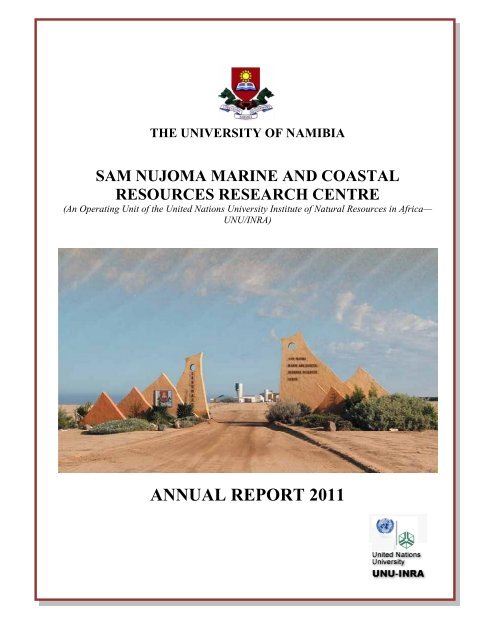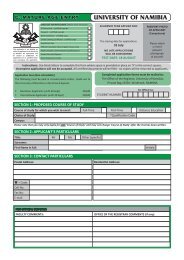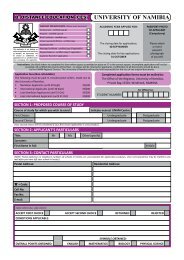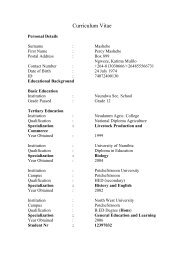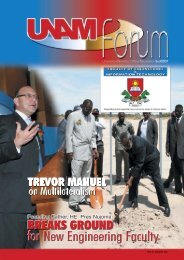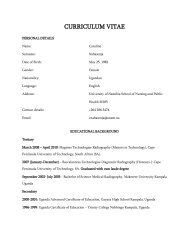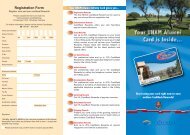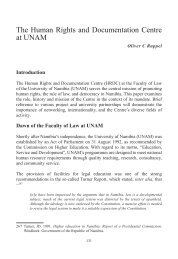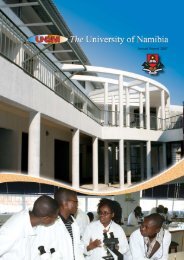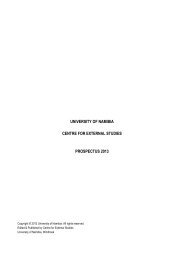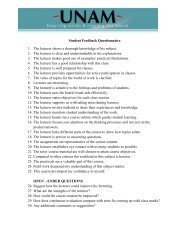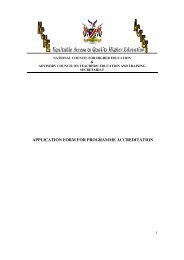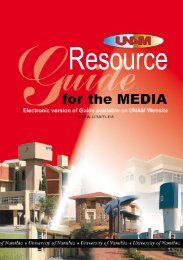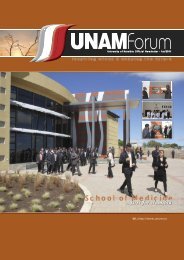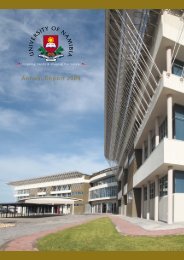ANNUAL REPORT 2011 - University of Namibia
ANNUAL REPORT 2011 - University of Namibia
ANNUAL REPORT 2011 - University of Namibia
Create successful ePaper yourself
Turn your PDF publications into a flip-book with our unique Google optimized e-Paper software.
THE UNIVERSITY OF NAMIBIA<br />
SAM NUJOMA MARINE AND COASTAL<br />
RESOURCES RESEARCH CENTRE<br />
(An Operating Unit <strong>of</strong> the United Nations <strong>University</strong> Institute <strong>of</strong> Natural Resources in Africa—<br />
UNU/INRA)<br />
<strong>ANNUAL</strong> <strong>REPORT</strong> <strong>2011</strong>
Table <strong>of</strong> Contents<br />
1. VISION ....................................................................................................................................... 1<br />
2. MISSION .................................................................................................................................... 1<br />
3. INTRODUCTION...................................................................................................................... 1<br />
4. STAFF MEMBERS OF THE CENTRE.................................................................................. 2<br />
5. SANUMARC’S STRATEGIC MANAGEMENT ACTION PLAN & BALANCED<br />
SCORECARD FOR <strong>2011</strong> ....................................................................................................... 3<br />
6. THE SANUMARC BOARD ..................................................................................................... 6<br />
7. MAJOR ACCOMPLISHMENTS DURING <strong>2011</strong> .................................................................. 7<br />
8. FACILITIES AND INFRASTRUCTURE .............................................................................. 9<br />
9. RESEARCH AND DEVELOPMENT ACTIVITIES ........................................................... 10<br />
Marine Science Research ........................................................................................................ 10<br />
Mariculture Research ............................................................................................................. 14<br />
Seaweed Research ................................................................................................................... 15<br />
Mushroom Research ............................................................................................................... 18<br />
Coastal agriculture & plant biodiversity research ............................................................... 19<br />
10 OTHER ACTIVITIES............................................................................................................ 22<br />
United Nations <strong>University</strong> Institute for Natural Resources in Africa 25th Anniversary . 22<br />
SANUMARC Trust ................................................................................................................. 22<br />
11 PUBLICATIONS: TECHNICAL <strong>REPORT</strong>S, SCIENTIFIC PRESENTATIONS AT<br />
CONFERENCES AND POSTERS ..................................................................................... 23<br />
Technical Reports .................................................................................................................... 23<br />
Scientific Presentations at Conferences ................................................................................ 23<br />
Scientific Posters ...................................................................................................................... 24<br />
12 TRAINING SUPPORT .......................................................................................................... 24<br />
13 COMMUNITY OUTREACH ................................................................................................ 25<br />
Science and Technology Promotion ....................................................................................... 25<br />
14 NOTABLE VISITORS TO THE CENTRE ......................................................................... 27<br />
15 ACKNOWLEDGEMENTS ................................................................................................... 28<br />
ii
1. VISION<br />
To become a centre <strong>of</strong> excellence in science and technology research in marine and coastal<br />
resources, in order contribute to global efforts to promote food security and eradicate poverty.<br />
2. MISSION<br />
To promote sustainable development and responsible utilisation <strong>of</strong> marine and coastal resources<br />
based on environmentally sound management for the benefit <strong>of</strong> <strong>Namibia</strong> and the people <strong>of</strong> the<br />
SADC region.<br />
3. INTRODUCTION<br />
SANUMARC had a rather quiet year in <strong>2011</strong>, this was primarily due to the coming to an end <strong>of</strong><br />
the stay <strong>of</strong> Dr. Larry Oellemann at the Centre and the search for a new substantive Director. Dr.<br />
Oellerman had acted as the Director since the beginning <strong>of</strong> 2010. Dr. Oellerman eventually<br />
resigned by May 31, <strong>2011</strong> and Pr<strong>of</strong>. Edosa Omoregie was appointed at the Director, effective, 01<br />
June, <strong>2011</strong>.<br />
Figure 1: Presentation <strong>of</strong> farewel gift to Dr. Larry Oellermann by the Chairperson <strong>of</strong><br />
SANUMARC Board, Pr<strong>of</strong>. Osmund Mwandemele<br />
For the most part, the few research activities and collaborations carried out were quite successful,<br />
most notable was the very successful research cruise carried out under the Science for the<br />
Assessment <strong>of</strong> Complex Earth System Processes (SPACES) programme which was coordinated<br />
by the Centre.<br />
The successful completion <strong>of</strong> a Ph.D. degree by the Deputy Director, Dr. Diina Shuuluka from<br />
the <strong>University</strong> <strong>of</strong> Cape Town, was the highest point <strong>of</strong> achievement recorded by the Centre in<br />
terms <strong>of</strong> staff development efforts. Similarly, the Office Administrator, Ms Elizabeth Hill also<br />
successfully completed a Diploma programme in Adult Education and Community Development<br />
from the <strong>University</strong> <strong>of</strong> <strong>Namibia</strong>.<br />
Management and staff <strong>of</strong> SANUMARC did excellently well in <strong>2011</strong> in their continuous strides in<br />
attracting visitors to the Centre. Partnerships and relationships with local, regional and<br />
international organisations and institutions grew go from strength to strength, and SANUMARC<br />
has gained the much needed international reputation.<br />
1
4. STAFF MEMBERS OF THE CENTRE<br />
For the very first time in many years, all the HR approved positions for the Centre were filled in<br />
<strong>2011</strong>, this was however, not with the various resignations that happened during the year. The<br />
beginning <strong>of</strong> the year, saw the resignation <strong>of</strong> Ms N. Amutenya, the Mariculture Technician. As<br />
stated earlier, Dr. Oellerman resigned as the Commonwealth Advisor for Aquaculture and Acting<br />
Director in May. Mr. Ryno M. Kajau, the Estates Officer resigned in April and, Mr. Fabian<br />
Mubiana, the Mushroom Researcher resigned in June.<br />
These resignations, however, did not deter the Centre Management in striving for greater heights.<br />
The Centre’s Management ensured that the vacant positions resulting from these resignations<br />
were filled, as well as making all efforts to fill already UNAM’s Management approved<br />
positions that were yet to be filled.<br />
Mr. Kaspar Shimooshili was appointed in June to fill the vacant Mariculture Technologist<br />
position, Ms. Martha Hausiku for the Mushroom Researcher’s position. The Coastal Agriculture<br />
Researcher position which has been vacant for two years was filled by the appointment <strong>of</strong> Mr.<br />
Edgar Mowa in the capacity <strong>of</strong> Researcher in November. Mr. Andreas Namwoonde was<br />
appointed in November as Renewable Energy Researcher, a position that has been so difficult to<br />
fill over the previous years.<br />
Table 1. SANUMARC staff complement for <strong>2011</strong>.<br />
Name<br />
Pr<strong>of</strong>. Edosa Omoregie 1<br />
Dr Larry K. Oellermann 2<br />
Dr. Diina Shuuluka<br />
Mr Flip van Vuuren<br />
Mr. Andreas Namwoonde<br />
Mr. Edgar M. Mowa<br />
Mr Marthinus N. Kooitjie<br />
Ms. Martha Hausiku<br />
Mr. Kaspar Shimooshili<br />
Mr Fabian Mubiana 3<br />
Mr Ryno M. Kajau 4<br />
Ms Elizabeth Hill<br />
1<br />
Appointed as Director in June<br />
2<br />
Resigned in May<br />
3<br />
Resigned in June<br />
4<br />
Resigned in April<br />
Position<br />
Director & Researcher (Marine Science)<br />
Commonwealth Advisor & Acting Director<br />
Deputy Director & Researcher (Seaweed)<br />
Projects Manager<br />
Researcher (Renewable Energy)<br />
Researcher (Coastal and Desert Agriculture)<br />
Assistant Researcher (Mariculture)<br />
Assistant Researcher (Mushrooms)<br />
Technologist (Mariculture)<br />
Technologist (Mushrooms)<br />
Estates Officer<br />
Office Administrator<br />
2
5. SANUMARC’S STRATEGIC MANAGEMENT ACTION PLAN &<br />
BALANCED SCORECARD FOR <strong>2011</strong><br />
The Strategic Management Action Plan (SMAP) and Balanced Scorecard for <strong>2011</strong> for<br />
SANUMARC, which cascades from the overarching UNAM Strategic Plan for <strong>2011</strong> to 2015 was<br />
implemented. However, the change in the leadership <strong>of</strong> the Centre slightly affected the full<br />
implementation, as <strong>2011</strong> was a transitional year in the Centre’s leadership. The Balanced<br />
Scorecard for <strong>2011</strong>, which measures progress towards achieving strategic objectives through a<br />
series <strong>of</strong> initiatives is presented herewith in Table 2. SANUMARC strategic objectives as they fit<br />
into the <strong>University</strong> overall objectives are presented in Table 3.<br />
3
Table 2. SANUMARC’s Balanced Scorecard for <strong>2011</strong>.<br />
Directorate Strategic<br />
Objectives<br />
Improve relevance <strong>of</strong> programs<br />
through stakeholder<br />
interaction<br />
Improve the capacity <strong>of</strong> staff<br />
Increase number <strong>of</strong> research<br />
projects<br />
Increase number <strong>of</strong> successful<br />
community outreach projects<br />
Improve dissemination <strong>of</strong><br />
information<br />
Maintain existing facilities &<br />
infrastructure<br />
Seek new partnerships &<br />
linkages & maintian existing<br />
relationships<br />
Increase sources <strong>of</strong> revenue for<br />
Centre<br />
Measures<br />
Target<br />
2010 Q1 Q2 Q3 Q4<br />
Initiatives Resp. Pers Timing<br />
Editions published 0 1 2 2 3 Newsletter for stakeholders Librarian / media <strong>of</strong>ficer<br />
March, July,<br />
November<br />
Resource<br />
Estimates Per<br />
initiative<br />
Not/Funded<br />
5000 Not funded<br />
Workshops 0 0 0 1 1 Stakeholder workshops Oellermann July 25000 Not funded<br />
Open days 0 0 0 1 1 Open days @ Centre van Vuuren July 10000 Not funded<br />
% Staff studying 30 40 40 50 50 Staff to continue with studies All staff Jan - Dec ---<br />
Training courses<br />
attended<br />
Mentorship<br />
relationships<br />
Number <strong>of</strong> new<br />
projects<br />
% Successful<br />
projects<br />
0 1 1 2 2 Staff to attend training courses All staff Jan - Dec 10000 Not funded<br />
0 0 1 1 2 Arrange staff mentorship programme All staff Jan - Dec 2500 Not funded<br />
0 1 2 3 4<br />
0 0 1 1 1<br />
Apply for additional researcher Oellermann Feb ---<br />
Attract stakeholder projects<br />
Attract visiting scientists<br />
Oellermann /Shuuluka<br />
/Mubiana /Kooitjie<br />
Oellermann /Shuuluka<br />
/Mubiana /Kooitjie<br />
Jan - Dec 4000 Not funded<br />
Jan - Dec 4000 Not funded<br />
Attract postgraduate projects Oellermann /Shuuluka Jan - Dec 4000 Not funded<br />
Commission study on community<br />
projects<br />
Publications 1 0 1 1 2 Publish in highly rated journals<br />
website reports 0 1 2 3 4<br />
Editions published 0 1 2 2 3<br />
Mubiana Jan - Dec 50000 Not funded<br />
Community workshop Mubiana April 25000 Not funded<br />
Use website to report project<br />
activities<br />
Use newsletter to make research<br />
accessable<br />
Oellermann /Shuuluka<br />
/Mubiana /Kooitjie<br />
Oellermann /Shuuluka<br />
/Mubiana /Kooitjie<br />
Librarian /media <strong>of</strong>ficer<br />
Jan - Dec 6000 Not funded<br />
Jan - Dec 1000 Not funded<br />
March, July,<br />
November<br />
Submissions 0 1 1 1 1 Apply for funds to refurbish facilities van Vuuren Feb ---<br />
Submissions 0 2 2 2 2 Apply for additional maintanence staff Oellermann Feb ---<br />
New partnerships 1 0 1 1 2<br />
Submissions 0 1 1 1 1<br />
5000 Not funded<br />
Visit potential partners Oellermann /Shuuluka Jan - Dec 40000 Not funded<br />
Invite potential partners to Centre<br />
Oellermann /Shuuluka<br />
/Mubiana /Kooitjie<br />
Jan - Dec 20000 Not funded<br />
Advertise for partnerships Librarian/media <strong>of</strong>ficer Jan - Dec 5000 Not funded<br />
Join large research programmes<br />
Apply for upgrading <strong>of</strong> conference<br />
facilities<br />
Consultancies 1 0 1 2 2 Tender for consultancies<br />
Oellermann /Shuuluka<br />
/Mubiana /Kooitjie<br />
Jan - Dec 5000 Not funded<br />
van Vuuren Feb ---<br />
Oellermann /Shuuluka<br />
/Mubiana /Kooitjie<br />
Jan - Dec ---<br />
Visitors per year 20 10 20 30 40 Offer accommodation at hostel Hill Jan - Dec ---<br />
4
Identical<br />
Contributing<br />
New<br />
N/A<br />
Table 3: Cascading Matrix for SANUMARC<br />
<strong>University</strong> <strong>of</strong> <strong>Namibia</strong> Strategic Objectives<br />
SANUMARC Strategic Objectives<br />
1. Improve relevance <strong>of</strong> programs X<br />
2. Improve quality <strong>of</strong> programs<br />
Improve relevance <strong>of</strong> programs<br />
through stakeholder interaction<br />
3. Improve student and staff welfare X Improve the capacity <strong>of</strong> staff<br />
4. Increase equitable access for students and<br />
staff<br />
5. Improve quality <strong>of</strong> teaching and learning<br />
6. Increase research output X Increase number <strong>of</strong> research projects<br />
7. Enhance community engagement X<br />
8. Improve registration process<br />
Increase number <strong>of</strong> successful<br />
community outreach projects<br />
9. Diversify dissemination <strong>of</strong> knowledge X Improve dissemination <strong>of</strong> knowledge<br />
10. Improve the delivery <strong>of</strong> quality extension<br />
services<br />
11. Strengthen international liaison and<br />
collaboration X Strengthen partnerships & linkages<br />
12. Optimize resource mobilization<br />
management<br />
13. Improve the corporate image<br />
14. Improve quality <strong>of</strong> library services<br />
15. Improve organizational culture<br />
16. Expand physical facilities internal<br />
17. Improve quality <strong>of</strong> operational services<br />
18. Improve efficiency and effectiveness <strong>of</strong><br />
examination systems<br />
19. Improve effective and adequate<br />
maintenance <strong>of</strong> all physical facilities<br />
20. Strengthen records and archives<br />
management and administration<br />
21. Strengthen Human capital management<br />
22. Develop and implement best practice in<br />
knowledge creation<br />
23. Improve ICT infrastructure and usage<br />
24. Diversify and increase sources <strong>of</strong> revenue<br />
sources<br />
25. Improve financial management<br />
26. Promote corporate governance<br />
X<br />
X<br />
Maintain existing facilities &<br />
infrastructure<br />
Increases sources <strong>of</strong> revenue for<br />
Centre<br />
5
6. THE SANUMARC BOARD<br />
The Board, previously known as the Advisory Board, remain the same for most part <strong>of</strong> <strong>2011</strong> as it was<br />
in 2010 with only minor changes. Ms. K. Imalwa, the National Planning Commission (NPC)<br />
representative withdrawn from the Board due to other commitments <strong>of</strong> the NPC, and the quest for a<br />
replacement by the NPC did not materialize. Pr<strong>of</strong>. Osmund Mwandemele, the Pro-Vice Chancellor<br />
for Academic Affairs and Research at the <strong>University</strong> <strong>of</strong> <strong>Namibia</strong> and SANUMARC’s founding<br />
Director, continued to Chair the Board in <strong>2011</strong>. During the year, Mr. Jan Arnold, the MD, NamSov<br />
and the representative <strong>of</strong> the Confederation <strong>of</strong> <strong>Namibia</strong>n Fishing Associations on the Board was<br />
unanimously appointed as the Deputy Chairperson <strong>of</strong> the Board.<br />
Table 4. The composition <strong>of</strong> the Board <strong>of</strong> SANUMARC for <strong>2011</strong><br />
Name<br />
Pr<strong>of</strong> Lazarus Hangula 1<br />
Pr<strong>of</strong> Osmund Mwandemele<br />
Ms. K. Imalwa 2<br />
Dr W. Jankowitz<br />
Ms Pandulani Elago<br />
Pr<strong>of</strong> E.M.R. Kiremire<br />
Dr Martin Schneider<br />
Dr H. MuAshekele<br />
Ms Lorna Mbwale<br />
Mr Job Jansen<br />
Mr Alois Fledersbacher<br />
Mr Jan Arnold<br />
Mr S. Iipinge<br />
Mr A. Van Kent<br />
Ms L. Mupetami<br />
Ms G. Cramer<br />
1 Ex-<strong>of</strong>ficio<br />
2<br />
Withdrew from the Board<br />
Institution<br />
Vice-Chancellor, <strong>University</strong> <strong>of</strong> <strong>Namibia</strong> (UNAM)<br />
Chair / PVC: Academic Affairs and Research, UNAM<br />
Deputy Director <strong>of</strong> Regional and Sectoral Planning: NPC<br />
Polytechnic <strong>of</strong> <strong>Namibia</strong><br />
Acting Director <strong>of</strong> Aquaculture, MFMR<br />
Dean, Faculty <strong>of</strong> Science<br />
Acting Dean, Faculty <strong>of</strong> Agriculture and Natural Resources<br />
Director, Multidisciplinary Research Centre (MRC)<br />
Director, UNAM Foundation<br />
Bursar, UNAM<br />
Registrar, UNAM<br />
MD, NamSov, Confederation <strong>of</strong> <strong>Namibia</strong>n Fishing Associations<br />
Acting Director, Research and Training, MAWF<br />
Director, Ministry <strong>of</strong> Education<br />
Deputy Director, Ministry <strong>of</strong> Environment and Tourism<br />
Mayor <strong>of</strong> Henties Bay Town<br />
6
Figure 2: Members <strong>of</strong> SANUMARC Board in <strong>2011</strong><br />
7. MAJOR ACCOMPLISHMENTS DURING <strong>2011</strong><br />
The Centre’s Deputy Director, Dr. Shuuluka successfully completed her doctorate studies from the<br />
<strong>University</strong> <strong>of</strong> Town in June <strong>2011</strong>. Her research examines the ecophysiology <strong>of</strong> the green seaweed<br />
Ulva (the ‘sea lettuce’) from an integrated aquaculture system and natural populations. The study<br />
encompasses a wide range <strong>of</strong> topics including commercial production and its optimization, effects <strong>of</strong><br />
a variety <strong>of</strong> environmental conditions on photosynthesis and growth in the laboratory, factors<br />
controlling seasonal patterns <strong>of</strong> commercially important components (protein and amino acids,<br />
nutrients, carotenes, minerals, heavy metals), and disease.<br />
Ms. Hill, the Centre’s Office Administrator successfully completed Diploma Programme in Adult<br />
and Community Development from the <strong>University</strong> <strong>of</strong> <strong>Namibia</strong> in May. Mrs. Hill has already moved<br />
forward registering for a Bachelor’s degree in Adult Education and Community Development which<br />
she is expected to complete in 2014.<br />
Figure 3: Dr. Diina Shuuluka and Ms. Elizabeth Hill at their graduation ceremony at the <strong>University</strong> <strong>of</strong> Cape Town and<br />
<strong>University</strong> <strong>of</strong> <strong>Namibia</strong> respectively.<br />
7
In recognition <strong>of</strong> the valuable contributions <strong>of</strong> Namsov to the <strong>University</strong> <strong>of</strong> <strong>Namibia</strong>, the <strong>University</strong><br />
top Management approved the naming <strong>of</strong> the recently constructed Researchers’ Residence as the<br />
Namsov Researchers’ Residence, the inauguration and naming ceremony <strong>of</strong> the residence was held<br />
on the September 16, <strong>2011</strong>.<br />
Within the months <strong>of</strong> September and October, the German research vessel, RV Maria S Merian was<br />
used to carry out a Training and Capacity Building Cruise in <strong>Namibia</strong>n waters. This was coordinated<br />
by SANUMARC and the Universities <strong>of</strong> Hamburg. The cruise was funded by the German Federal<br />
Ministry <strong>of</strong> Education and Research under the SPACES programme. The aim <strong>of</strong> this cruise was to<br />
contribute to a better understanding <strong>of</strong> the Benguela Current Ecosystem and thereby fostering the<br />
cooperation within the SPACES programme by helping in setting up partnership projects in research<br />
and development. This research-based capacity building brought together researchers and students<br />
from ten different African countries and Germany on board RV Maria S Merian. A second major<br />
goal was to educating undergraduate and graduate students in different marine disciplines by using<br />
an integrated Earth System Science approach (see Box 1 for a personal experience by a Third year<br />
<strong>University</strong> <strong>of</strong> <strong>Namibia</strong> Biology student). The cruise was separated into three legs <strong>of</strong> 10 days duration<br />
each. Each leg was focused on one discipline,<br />
Leg 1: September, 23 to October, 01: Physical Oceanography (Cruise leader: Pr<strong>of</strong>. Martin Visbeck,<br />
IFM-GEOMAR Kiel).<br />
Leg 2: October, 02 11: Marine Biology and Biogeochemistry (Cruise leader Dr. Werner Ekau, ZMT<br />
Bremen).<br />
Leg 3: October, 12 to 21, Marine Geology (Cruise leader: Dr. Matthias Zabel, MARUM <strong>University</strong><br />
<strong>of</strong> Bremen).<br />
Figure 4: RV Maria S Merian is the most recent and most modern addition to the German fleet <strong>of</strong> research vessels. With<br />
a length <strong>of</strong> 95 m and a beam <strong>of</strong> 19 m she has more than 150 m 2 in laboratory space and can host 22 scientists on cruises<br />
up to 40 days long.<br />
8
Figure 5: Leg 2 Cruise Participants group photograph<br />
Box 1: Cruise Report by Simon Nkumbwa, final year student, Department <strong>of</strong> Fisheries and<br />
Aquatic Sciences, <strong>University</strong> <strong>of</strong> <strong>Namibia</strong><br />
MSM19/1a<br />
(22.09.<strong>2011</strong> – 01.10.<strong>2011</strong>)<br />
This cruise was very educative, especially to future marine scientists in <strong>Namibia</strong>. It was my first<br />
time in life to observe and use equipments that we usually read and see in text books. I gained<br />
knowledge on how to use equipment such the CDT, ADCP, MOORING, PHYTOPLANKTON<br />
NET, SALINOMETER, GLIDER and the most amazing was using the s<strong>of</strong>tware MATLAB to<br />
plot the graphs <strong>of</strong> salinity, oxygen, temperature and more<br />
It was very great moments because I learned a lot starting from the educational activities such as<br />
CDT transect analysis salinity from CDT raw data, watching the vessel crew deploying the<br />
mooring submerged in water for 5 days and the mini science project we students work on during<br />
the cruise. Apart from the student’s mini project that we did, Pr<strong>of</strong> Martin Visbeck gave several<br />
lectures on oceans around the globe. There were great moments we shared together during the<br />
cruise; from my fellow students from German, South Africa, Tanzania, and Mozambique. Each<br />
and every one <strong>of</strong> us learned something weather its educational, religious, cultures and the<br />
institutional and countries that we represented.<br />
Lastly I would like to thank the German scientist who showed us the use <strong>of</strong> this equipment for<br />
collecting oceanographic data, especial the Chief Scientist Pr<strong>of</strong> Martin Visbeck and his staff for<br />
the good work that they did form the beginning to the end <strong>of</strong> the Leg1. Big thanks go to Captain<br />
Matthias Günther, his <strong>of</strong>ficers and crew <strong>of</strong> RV MERIAN for their support during the cruise.<br />
8. FACILITIES AND INFRASTRUCTURE<br />
The much anticipated commencement <strong>of</strong> the development <strong>of</strong> infrastructure for the Department <strong>of</strong><br />
Fisheries and Aquatic Sciences did not take place in <strong>2011</strong> as anticipated. However, progress was<br />
made in the design <strong>of</strong> the girls’ hostel and administration block for which tender documents were<br />
9
completed. The constructions <strong>of</strong> these facilities are expected to commence in 2012, after approval by<br />
the <strong>University</strong>’s Tender Board.<br />
The Centre added to its facilities a 6 × 6 m cold-room and a modern freeze-dryer with funds provided<br />
by the Government <strong>of</strong> Norway through the BSc Fisheries and Aquatic Sciences programme for<br />
SADC region. The cold-room is to be used in the archiving <strong>of</strong> the various precious <strong>Namibia</strong>n marine<br />
resources for future generations. The Cold-room was acquired with a view <strong>of</strong> setting up a Regional<br />
Marine Museum at the Centre.<br />
9. RESEARCH AND DEVELOPMENT ACTIVITIES<br />
Marine Science Research<br />
Several research outputs from the German RV Maria S. Merian research cruise were achieved<br />
coupled with the cruise objectives <strong>of</strong> capacity building within the Region. Posters from some <strong>of</strong> the<br />
research activities during the cruise were presented at the 3rd Annual Science <strong>of</strong> the Benguela<br />
Current Commission (BCC) held in Swakopmund, 17 to 19 October.<br />
Outlines and summaries <strong>of</strong> selected reports are presented below:<br />
Title: Distribution <strong>of</strong> main ichthyoplankton in the Benguela Upwelling System<br />
Authors: Mokanya Erikka (<strong>University</strong> <strong>of</strong> <strong>Namibia</strong>); Nina Schickenberg (<strong>University</strong> <strong>of</strong> Bremen);<br />
Claas Steigüber (<strong>University</strong> <strong>of</strong> Bremen); Francisco Souza Dias (UPMC Paris) and Paula Pattrick<br />
(Nelson Mandela <strong>University</strong>)<br />
Introduction: The benguela current ecosystem is one <strong>of</strong> the world‘s major upwelling system. As<br />
is typical <strong>of</strong> the earstern-boundary upwelling system, it is characterized by high productivity and<br />
a greatly dynamic nature. The benguela ecosystem supports large population <strong>of</strong> living marine<br />
resources that are <strong>of</strong> substantial economic importance to the region, such as fisheries.<br />
Knowledge about the distribution <strong>of</strong> fish larvae, is essential to understand future stock<br />
recruitment, because this stage <strong>of</strong> live is the most valnurable in the whole live history <strong>of</strong> fish.<br />
That’s why, we took the chance to participate in the teaching cruise MSM 19 -1b in the<br />
framework <strong>of</strong> the GENUS project, to survey the distribution <strong>of</strong> fish larvae, identify hotspots and<br />
dominating species and compare these with major oceanographic parameters.<br />
Methods: Fish larvae were caught with a multinet (5 nets, 500 µm mesh size) from certain<br />
standardized depths. Caught larvae were characterized with a dissecting microscope, using state<br />
to the art determination literature. These findings were further compared with oceanographic<br />
data from a CTD, which was run at each station.<br />
Results: Two main species Suffogobius birbatus and Lampanyctodes hectoris dominating the<br />
ichthyoplankton were observed. The total abundance <strong>of</strong> fish larvae increased with oxygen<br />
concentration. Lampanyctodes hectoris prefers warm water and suffogobius birbatus occurs in<br />
colder waters close to the shore, but in areas that are not affected by oxygen depleted upwelled<br />
waters. Their hotspots were found around moderate temperature regions and relatively high<br />
oxygen areas hence their abundance.<br />
10
Figure 6: The distribution <strong>of</strong> the main ichthyoplankton in the upper surface water <strong>of</strong> <strong>Namibia</strong> central marine<br />
environment<br />
Conclusion: Based on the recorded data major larval hot spots occured around oxygen supplied<br />
regions and moderate temperatures. This is important for the fisheries as this provide<br />
recruitment. The study provides a stepping stone to ensure and enable sustainable fisheries<br />
management <strong>of</strong> ocean resources thus ensuring food safety.<br />
Title: Frequency <strong>of</strong> occurrence <strong>of</strong> seabirds, marine mammals and jellyfish in Central <strong>Namibia</strong>n<br />
waters<br />
Authors: Gabriel Chiloia (<strong>University</strong> <strong>of</strong> <strong>Namibia</strong>), Katharina Schwinghammer (Bremen <strong>University</strong>).<br />
Introduction: The <strong>Namibia</strong>n coastal waters contain a great abundance <strong>of</strong> predators such<br />
as marine mammals, seabirds and also jellyfish. Marine mammals are cetaceans and fur seals<br />
which are highly adapted to the marine environment. The seal species which occurs in <strong>Namibia</strong><br />
is the Cape Fur Seal (Arctocephallus pusillus) which belongs to the eared seals. The most<br />
common dolphins are the Dusky Dolphin (Lagenorhynchus obscurus) and the Heaviside<br />
Dolphin (Cephalorhynchus heavisidii). Seabirds are commonly seen over the open ocean<br />
thousands <strong>of</strong> kilometers from land, but all birds must come ashore to raise their young. Jellyfish<br />
is the common name for any <strong>of</strong> the invertebrate animals making up two classes <strong>of</strong> the cnidarians.<br />
The term jellyfish applies more specifically to the free-swimming, gelatinous organism called<br />
the medusa. Jellyfish have little nutritional value and therefore they are usually not fed upon.<br />
Method: Seabirds and marine mammals were counted within each 10 minute interval while the<br />
vessel was moving. Jellyfish abundance <strong>of</strong> the two predominant species (Chrysaora and<br />
Aequorea) was recorded within a distance <strong>of</strong> 30 meters from the vessel while cruising.<br />
Results: Greatest abundances <strong>of</strong> jellyfish were observed around 21°S. Highest occurrence <strong>of</strong><br />
Chrysaora Fig.1, right) was found around 120 nm <strong>of</strong>fshore, whereas Aequorea (Fig. 1, left)<br />
occurred over the shelf area closer to the coast. Cetaceans were both observed on the shelf and<br />
far <strong>of</strong>fshore. We saw Dusky Dolphins, Pilot Whales and Fin whales (Fig. 2). High abundances <strong>of</strong><br />
seals were found close to the coast where there are large seal colonies i.e. at Cape Cross (22°S,<br />
14°E) (Fig. 3). Peak abundance <strong>of</strong> seabirds was <strong>of</strong>f Henties Bay around 45 nm from the shore.<br />
11
Figure 7: Distribution <strong>of</strong> Aequorea (left) and Chrysaora (right) along the central <strong>Namibia</strong>n coast<br />
Figure 8: Distribution <strong>of</strong> Cetacea along Central <strong>Namibia</strong>n coast. Yellow: Dusky Dolphins, Blue: Pilot whales, Red:<br />
Fin whales.<br />
Figure 9: Distribution <strong>of</strong> Fur Seals and seabirds along Central <strong>Namibia</strong>n coast<br />
Conclusion<br />
The two species <strong>of</strong> jellyfish that were observed did not necessarily occur at the same places. We<br />
also found that seabirds and seals occurred together in many places. This might be linked to the<br />
distribution <strong>of</strong> their food, which is fish.<br />
Title: Nutrient cycle and the relevance <strong>of</strong> the Benguela Upwelling System for the biological pump<br />
Authors: Jeorgina Chiquequela (UNIversity <strong>of</strong> <strong>Namibia</strong>); Thulwaneng Mashifane (<strong>University</strong> <strong>of</strong><br />
Cape Town) and Juvinaries Nyandoto (<strong>University</strong> <strong>of</strong> <strong>Namibia</strong>)<br />
12
Introduction<br />
The Benguela is one <strong>of</strong> the four major upwelling ecosystems in the world and extends from<br />
South Angola, <strong>Namibia</strong> and South Africa. During upwelling water enriched with nutrients<br />
including Silicate, Phosphate and Nitrate reach the biologically productive surface <strong>of</strong> the ocean<br />
enhancing phytoplankton production. While the upwelling promotes primary production, the<br />
deeper waters with limited Oxygen exchange create hypoxic areas called oxygen minimum zones<br />
on the continental shelf. Phytoplankton blooms resulting from upwelling events provide the<br />
biological basis for transporting fixed carbon into the deep ocean (biological pump). This is<br />
achieved by carbon fixation (photosynthesis) and the processes <strong>of</strong> direct sedimentation <strong>of</strong> cells<br />
into the deep ocean as particulate organic carbon (POC).<br />
During the Maria S. Merian Cruise (Leg II/1b) nutrient cycle and the relevance <strong>of</strong> the Benguela<br />
Upwelling System for the biological pump was studied.<br />
Results<br />
Remineralisation <strong>of</strong> Phosphates takes place in the Oxygen minum zone ~ 350 m, during<br />
decomposition <strong>of</strong> phytoplankton cells (Figure 2 - 6). The decomposition cells transport carbon<br />
from the sea surface and bring it deep to the ocean floor through the biological pump.<br />
Figure 10: Dissolved oxygen and phosphate concentrations with depth for the stations investigated<br />
Figure 11: Dissolved oxygen and phosphate concentrations with the oxygen minimum zone (~ 350 m) in the<br />
Benguela upwelling system<br />
Conclusion<br />
Oxygen and phosphate are inversely proportional with depth. Poorly Dissolved Oxygen (DO)<br />
from the sea bottom utilize maximum oxygen in the oxygen minimum zone (~350–500 m),<br />
simultaneously releasing phosphate during decomposition <strong>of</strong> cells until sea floor.<br />
13
Title: CO 2 emission from the Benquela Upwelling System.<br />
Authors: Pillay, K. (Rhodes <strong>University</strong>), Schickenberg N. (<strong>University</strong> <strong>of</strong> Bremen), Steigüber, C.<br />
(<strong>University</strong> <strong>of</strong> Bremen), Mokanya, E. (<strong>University</strong> <strong>of</strong> <strong>Namibia</strong> and Chiquequela, J. (Augustinho Neto<br />
<strong>University</strong>)<br />
Introduction<br />
It has become increasingly important to understand the ocean carbon cycle as it is a major<br />
contributor in controlling atmospheric CO 2 (a greenhouse gas contributing to climate change). A<br />
characteristic <strong>of</strong> upwelling areas is that cold, nutrient-rich and CO 2 rich waters are brought to the<br />
surface. The pCO 2 <strong>of</strong> the shelf waters <strong>of</strong> the Northern Benguela has not been measured. This<br />
study was a first in understanding the carbon cycling within the Northern Benguela. Continuous<br />
underway pCO 2 , sea surface temperature (SST), bathymetry measurements are presented.<br />
Results<br />
Preliminary analysis shows pCO 2 variability between inshore and <strong>of</strong>fshore waters. Inshore<br />
measurements indicate cells <strong>of</strong> high pCO 2 concentration which can be representative <strong>of</strong><br />
upwelling cells. This elevated pCO 2 appears to be correlated to low SST and shows a possible<br />
link to coastal bathymetry.<br />
Conclusion<br />
The identified upwelling cells (high pCO 2 ) show the expected trend <strong>of</strong> low SST. These factors<br />
appear to be klinked to coastal bathymetry. The coastal bottom topography could be a<br />
contributing factor to the permanent upwelling in the Northern Benguela. This links needs to be<br />
further investigated.<br />
Mariculture Research<br />
Silver Kob, Argyrosomus inodorus, juvenile feeding trials<br />
This experiment was aimed at investigating the optimum feeding rate <strong>of</strong> the Silver Kob under<br />
laboratory conditions. The juvenile system was stocked with the cohort <strong>of</strong> the 2009 spawned fish<br />
which was divided into eight experimental tanks with 10 fish per tank. Each tank was fed a fixed<br />
amount <strong>of</strong> scientifically formulated feed at 2, 4, 8 and 10% fish body mass per day for a period <strong>of</strong> 6<br />
months. Each feeding rate had a replicate. The experimental feed was obtained from Marifeed®<br />
company, based on a diet developed by Rhodes <strong>University</strong> specifically for Kob.<br />
All the fish were weighed & measured every two weeks, amount <strong>of</strong> feed over the following 2 weeks<br />
were adjusted accordingly. Growth (mass & length), condition factor and food conversion ratio<br />
(FCR) were calculated. At the end <strong>of</strong> the feeding trial, growth trend was suggesting a positive<br />
growth projected by fish fed 8% body weight, with the specific growth rate (SGR) <strong>of</strong> 2.3, 2.2, 4.4<br />
and 1.2 g/day obtained for fish fed 2, 4, 8 and 10% body weight per day, respectively.<br />
14
Figure 12: Mean growth and specific growth rate <strong>of</strong> theSilver kob (A. inodorus) juvenile subjected to different feeding<br />
rates (%BW) for 6 months under laboratory conditions.<br />
Seaweed Research<br />
During <strong>2011</strong>, three notable research activities in seaweed are worth reporting.<br />
Glycerol-production system from halophytes occurring naturally in salt pans<br />
In 2010, halophytic microalgae strains were collected from a salt pan along the <strong>Namibia</strong>n coast and<br />
samples from SANUMARC and taken to the United Kingdom for strain analysis and glycerol<br />
production. This was collaboration with the <strong>University</strong> <strong>of</strong> Greenwich and the Marine Biological<br />
Association. PCR sequencing <strong>of</strong> genes and phylogenetic analyses <strong>of</strong> the strains and glycerol<br />
production were performed.<br />
Figure 13: Dunaliella and Asteromonas strains isolated were found to be genetically distinct from all other known<br />
Dunaliella strains, they showed the potential <strong>of</strong> commercial production <strong>of</strong> glycerol.<br />
Analysis <strong>of</strong> the ITS region showed T35, T36 and T37 were genetically distinct from other Dunaliella<br />
species, therefore forming a unique group. Sizing the PCR products <strong>of</strong> the 18S rRNA gene for T35,<br />
T36 and T37 indicated no introns were present for these three strains. The research also revealed that<br />
the <strong>Namibia</strong> strains <strong>of</strong> Dunaliella may be better adapted for growth at high temperatures (30 O C) than<br />
low. Doubling times and specific growth rate µ provide the basis for modelling production systems<br />
to produce industrial quantities <strong>of</strong> glycerol in <strong>Namibia</strong>.<br />
15
Growth rates <strong>of</strong> Gracilariopsis funicularis (Gracilariaceae, Rhodophyta) in laboratory culture<br />
under varying salinities<br />
During the end <strong>of</strong> the year, Mr. Stehanus Hamuntenya,a final student from the Department <strong>of</strong><br />
Fisheries and Aquatic Sciences was at the Centre where he carried out a research titled: Growth rates<br />
<strong>of</strong> Gracilariopsis funicularis (Gracilariaceae, Rhodophyta) in laboratory culture under varying<br />
salinities, under the supervision <strong>of</strong> Dr. Shuuluka and Mr. Tjipute.<br />
Measurements <strong>of</strong> fresh weight <strong>of</strong> Gracilariopsis funicularis indicated that fresh weights at salinity<br />
level <strong>of</strong> 40ppt was increasing rapidly between day 3 to day 18 as compared to salinities <strong>of</strong> 25 ppt<br />
and 35 ppt. However from day 18, the fresh weights increased rapidly at salinity <strong>of</strong> 25 ppt as<br />
compared to salinity <strong>of</strong> 35 and 40 ppt. During day 21 and day 24, plants growing in salinity <strong>of</strong> 35 ppt<br />
seem to decrease in weight. The specific growth rate per day (%/day) showed that the plants grew<br />
well in all salinities tested. All salinities provided a faster growth rate until day 12 and the growth<br />
started to decrease thereafter. It worth noting that salinity <strong>of</strong> 35 ppt had the lowest growth rate as<br />
from day 21 until the end <strong>of</strong> the experimental period, with growth rate ranging from 1.58 to 1.26<br />
%/day. However, statistical analysis indicated that there was no significant difference in the growth<br />
rate <strong>of</strong> Gracilariopsis funicularis grown at the various salinities (p > 0.05). From observations during<br />
the experimental period, after day 18, Ulva started to appear in the flasks that were incubated at 25<br />
and 35 ppt, however, appearance <strong>of</strong> Ulva at 40 ppt flask was not observed.<br />
Commercial cultivation and processing <strong>of</strong> seaweeds should be a national priority and taken up as a<br />
mission mode project. Setting up agar extraction companies in <strong>Namibia</strong> can provide the much needed<br />
employment among the youths, thereby leading to reduction in unemployment. This study provided<br />
benchmark information for future study on the eco-physiology <strong>of</strong> the red seaweed species,<br />
Gracilariopsis funicularis in <strong>Namibia</strong>.<br />
16
Fresh weights(g)<br />
SGR (% d-1)<br />
a<br />
Figure 14: (a) Well cleaned thalli <strong>of</strong> Gracilariopsis funicularis ready for incubation<br />
(b) Gracilariopsis funicularis in in Erlenmeyer flasks containing different salinities<br />
b<br />
8 25ppt 35ppt 40ppt<br />
6<br />
25ppt 35ppt 40ppt<br />
6<br />
4<br />
4<br />
2<br />
2<br />
0<br />
0 10 20 30<br />
Days<br />
0<br />
0 10 20 30<br />
Days<br />
Figure 15: Mean fresh weight and specific growth rate (SGR) <strong>of</strong> Gracilariopsis funicularis incubated under laboratory<br />
conditions for 30 days.<br />
Proximate analysis <strong>of</strong> the <strong>Namibia</strong>n Kelp (Laminaria pallida)<br />
During November,<strong>2011</strong>, Dr Shuuluka spent few days at the Ministry <strong>of</strong> Agriculture, Water and<br />
Forestry (MAWF), Nutritional Laboratory in Windhoek carrying out proximate analysis <strong>of</strong> <strong>Namibia</strong>n<br />
Kelp (Laminaria pallida) samples collected during low tide from Solitude Point (22°09'40S,<br />
14°17'14E) along Henties Bay shore.<br />
It is important to determine the nutritional content <strong>of</strong> the kelp as it will be used as a chicken feed<br />
supplement in a research project that will be conducted during the second quarter <strong>of</strong> 2012. Table 5<br />
below shows the proximate values for the dried powdered kelp. The protein value is yet to be<br />
determined, this will be done in 2012.<br />
17
Figure 16: Collection <strong>of</strong> beach-cast Laminaria pallida<br />
Table 5: Proximate composition <strong>of</strong> dried powdered kelp<br />
Component<br />
Dry weight<br />
(%)<br />
Moisture 14.36 ± 0.13<br />
Sodium (Na) 2.90 ± 0.03<br />
Calcium (Ca) 1.62 ± 0.01<br />
Phosphorus (P) 0.38 ± 0.01<br />
Crude fiber (CF) 7.01 ± 0.04<br />
Fat 0.65 ± 0.07<br />
Ash 50.66 ± 0.90<br />
Mushroom Research<br />
The resignation <strong>of</strong> Mr. Mubiana in mid June <strong>2011</strong> halted the research activities in mushroom, until<br />
the appointment <strong>of</strong> Ms. Hausiku during the third quarter <strong>of</strong> the year.<br />
Since Ms. Hausiku’s appointment, the focus <strong>of</strong> the Centre’s mushroom activities has been that <strong>of</strong><br />
recuperation <strong>of</strong> mushroom R & D and production <strong>of</strong> quality spawn for future research as well as<br />
supplying to the Community. Towards the end <strong>of</strong> <strong>2011</strong>, quality spawns were eventually developed<br />
and are being used to inoculate wheat straws. The whole restoration process has been successful and<br />
the first fruiting bodies were harvested on 30 January 2012.<br />
18
Figure 17: Mushroom R & D and production at SANUMARC<br />
Coastal agriculture & plant biodiversity research<br />
For most part <strong>of</strong> <strong>2011</strong>, the Centre had no researcher in coastal agriculture and plant biodiversity<br />
research, until the appointment <strong>of</strong> Mr. Mowa during the last quarter on the year. Since his<br />
appointment, the focus has been on the recuperation <strong>of</strong> the greenhouse and the shade-net garden,<br />
which is still on-going.<br />
As part <strong>of</strong> the on-going Southern African Norway Tertiary Education Development (SANTED)<br />
project, Mrs. Devota Kavishe spent considerable time at the Centre collecting desert plants to enrich<br />
the <strong>Namibia</strong>n database collection.. In June and November <strong>2011</strong>, field trips were organized to collect<br />
plant specimens from Kuiseb valley, Henties Bay lichen field, OMDEL, Uis town and its environs,<br />
Namib rock and Brandberg areas. Several plant specimens were collected and 63 specimens were<br />
processed for the herbarium. These specimens belong to 23 plant families. Fifty four (54) were<br />
herbaceous and 9 shrubby. SANUMARC Herbarium Checklist is presented in Table 6.<br />
The task <strong>of</strong> collecting plants for any herbarium is tedious and delicate. Some <strong>of</strong> the specimens<br />
collected did not dry properly or loose important parts such as flowers and fruits and thus discarded<br />
as they are not fit for display. The rainy season in <strong>2011</strong> was extended and the Kuiseb River was still<br />
flowing when the exercise was taking place. The Omaruru river bed was still damp. Rare wetland<br />
species like Nesaea luedritzii come out during periods <strong>of</strong> extended river dampness. Of the specimens<br />
added to the herbarium in <strong>2011</strong>, 6 were collected from Brandberg, 10 from Kuiseb valley, 7 from<br />
Lichen field, 11 from Namib rock, 9 from Omaruru river-bed and delta (OMDEL), and 20 from Uis<br />
town and its environs.<br />
Table 6: SANUMARC Herbarium Species Checklist (<strong>2011</strong>)<br />
SPECIES NAME FAMILY LOCATION<br />
Acrotome fleckii (Gurke) Launert Lamiaceae Namib rock<br />
Acrotome flekii (Gurke) Launert Lamiaceae Uis<br />
Aizoanthemum galenioides (Fenzle ex Sond.) Friedrich Aizoaceae Namib rock<br />
Aizoanthemum rehmanii (Schinz) H.E.K. Hartmann Aizoaceae OMDEL<br />
19
SPECIES NAME FAMILY LOCATION<br />
Amaranthus cf. dinteri Schinz subsp. dinteri Amaranthaceae Kuiseb<br />
Anticharis inflata Marloth & Engl. Scrophulariaceae Uis<br />
Aristida parvula (Nees) De Winter Poaceae OMDEL<br />
Brachiaria glomerata (Hack. ) A. Camus Poaceae OMDEL<br />
Brachiaria glomerata (Hack.) A. Camus Poaceae Lichen field<br />
Calostephane marlothiana O. H<strong>of</strong>fm Asteraceae OMDEL<br />
Chascanum garipense E Mey Verbenaceae Kuiseb<br />
Chenopodium murale L. Pteridaceae Kuiseb<br />
Chloris virgata SW Poaceae Kuiseb<br />
Citrullus rehmii De Winter Cucurbitaceae Uis<br />
Crotalaria damarensis Engl Fabaceae Uis<br />
Cucumis sagittatus Peyr. Cucurbitaceae Uis<br />
Cynodon dactylon (L.) pers Poaceae Uis<br />
Dactyliandra welwitschii Hook.F Cucurbitaceae Uis<br />
Dauresia alliariifolia (O. H<strong>of</strong>fm.) B. Nord & Palser Cucurbitaceae Namib rock<br />
Dicoma tomentosa Cass Asteraceae Namib rock<br />
Dyerophtum africanum (Lam.) Kuntze Plumbaginaceae Namib rock<br />
Eragrostis annulata Rendle ex Scott-Elliot Poaceae Namib rock<br />
Eragrostis glandulosipedata de Winter Poaceae Uis<br />
Fingerhuthia africana Lehm Poaceae Uis<br />
Galenia papulosa (Eckl.) & zeyh.) Sond Aizoaceae Kuiseb<br />
Gazania jurineifolia D.C. subsp scabra (D.C.) Roessler Asteraceae Kuiseb<br />
Hermannia solaniflora (K. Schum) Sterculiaceae OMDEL<br />
Hermbstaedtia linearis Schinz Amaranthaceae Brandberg<br />
Hirpicium gazanioides (Harv.) Roesslar Asteraceae Uis<br />
Hypertelis caespitosa Friedrich Molluginaceae Lichen field<br />
Indig<strong>of</strong>era auricoma E. Mey Fabaceae Uis<br />
Jamesbrittenia tenella (Hien.) Hilliard Scrophulariaceae Namib rock<br />
Lessertia pauciflora Harv. var pauciflora Fabaceae Uis<br />
Limeum-argute-carinatum Warwa ex Warwa & Molluginaceae Uis<br />
Peyr.var argute-carinatum<br />
Lotononis platycarpa (Viv) Pic-Serm Hyacinthaceae Namib rock<br />
Melinis repens (Wild.) Zizka sub sp grandiflora Poaceae Brandberg<br />
20
SPECIES NAME FAMILY LOCATION<br />
(Hochst) zizka<br />
Merremia guerichii A. Meeuse Convolvulaceae OMDEL<br />
Monandrus squarrosus (L.) Vorster sub sp squarrosus Cyperaceae Kuiseb<br />
Monechma genistifolium(Engl.) C.B Clarke Acanthaceae Namib rock<br />
Monsonia umbellata Harv Geraniaceae Uis<br />
Nelsia quadrangula (Engl. ) Schinz Amaranthaceae Brandberg<br />
Nesaea Luedritzii ex Schinz var luedritzii Lythraceae OMDEL<br />
Pavonia rehmanii Malvaceae Uis<br />
Pennisetum foermerianum Leeke Poaceae Namib rock<br />
Phyllanthus petandrus Schumach Euphorbiaceae Brandberg<br />
Pogonarthria fleckii (Hack.) Hack Poaceae Kuiseb<br />
Ptycholobium biflorum (E. Mey.) Fabaceae Uis<br />
Schmidtia kalahariensis Stent Poaceae Uis<br />
Senecio engleranus O. H<strong>of</strong>fm Asteraceae Lichen field<br />
Senecio engleranus O. H<strong>of</strong>fm Asteraceae Lichen field<br />
Stipagrostis ciliata (Desf.) De Winter var capensis (Trin Poaceae<br />
Lichen field<br />
& Rupr.) De Winter<br />
Stipagrostis hirtigluma (Trin & Rupr.) De Winter Poaceae<br />
OMDEL<br />
subsp.pearsonii(Henrard) De Winter<br />
Stipagrostis subacaulis (Nees) De Winter Poaceae Uis road<br />
Stipagrostis uniplumis (Licht) var intermedia<br />
Poaceae<br />
Uis<br />
(Schweick.) De winter<br />
Tetragonia decumbens Mill Aizoaceae Lichen field<br />
Trianthema parvifolia E. Mey ex Sond Aizoaceae Lichen field<br />
Tribulocarpus dimorphanthus (Pax) S. Moore Aizoaceae Brandberg<br />
Trichodesma africanum (L.) Lehm Boraginaceae Uis<br />
Tricholaena monachne (Trin.) Stapf & C. E. Hubb Poaceae Namib rock<br />
Tripteris microcarpa Harv subsp. microcarpa Asteraceae Kuiseb<br />
Tripteris spp Asteraceae Brandberg<br />
Triraphis pumilio R. Br. Poaceae OMDEL<br />
Vahlia capensis (L.f.) Thunb Vahliaceae Kuiseb<br />
21
10 OTHER ACTIVITIES<br />
United Nations <strong>University</strong> Institute for Natural Resources in Africa 25th<br />
Anniversary<br />
The United Nations <strong>University</strong> Institute for Natural Resources in Africa (UNU-INRA) <strong>of</strong> which<br />
SANUMARC is an affiliated operating institute held an International Conference in Accra, Ghana<br />
from 05 – 07 December to mark its 25th anniversary. The three-day international conference was<br />
attended by representatives from government Ministries, Departments and Agencies in Ghana; the<br />
diplomatic community, UNU staff worldwide, the donor community, as well as academicians from<br />
various universities across the world. Pr<strong>of</strong>. Osterwalder, the Rector <strong>of</strong> the United Nations <strong>University</strong>,<br />
congratulated UNU-INRA for organizing a successful conference and admonished participants to<br />
actively think <strong>of</strong> how to support the Institute and its operating units in different parts <strong>of</strong> Africa and its<br />
twinning partner in Tokyo. SANUMARC participated actively in this event; Pr<strong>of</strong>essor Omoregie<br />
presented a paper on Mushroom research and activities in <strong>Namibia</strong>.<br />
The conference, among other things, created the platform for dialogue amongst academicians and<br />
policy makers on charting a new course for future research, training and capacity development in<br />
Africa. It was also to mobilize African perspectives on the development <strong>of</strong> natural resources for the<br />
Rio +20 conference on sustainable development in 2012.<br />
(a)<br />
Figure 18: SANUMARC participation at the 25th Anniversary <strong>of</strong> UNU-INRA celebrations in Accra, Ghana: Group<br />
photography <strong>of</strong> all participants (a) and Ms. Martha Hausiku in front <strong>of</strong> SANUMARC poster on Mushroom research and<br />
community activities in <strong>Namibia</strong>.<br />
<strong>2011</strong> also witnessed the twining <strong>of</strong> UNU-INRA and United Nations <strong>University</strong> Institute for<br />
Sustainability and Peace (UNU-ISP). This arrangement will further enhance the visibility <strong>of</strong><br />
SANUMARC within the United Nations <strong>University</strong> institutions worldwide.<br />
SANUMARC Trust<br />
The Namsov Community Trust endowed a NAD 1 million Trust, known as The SANUMARC Trust<br />
for the Sam Nujoma Marine and Coastal Resources Research Centre. One <strong>of</strong> the objectives <strong>of</strong> this<br />
Trust is to fund research activities in the Centre that falls under the Research Mandate <strong>of</strong><br />
SANUMARC and beneficial to the <strong>Namibia</strong>n Nation.<br />
(b)<br />
22
The Centre was given approval to institute a Namsov Trust Postgraduate Scholarship Scheme by the<br />
Resource Mobilization and Liaison Committee (RMLC) and the recommendation <strong>of</strong> the RMLC was<br />
approved by SANUMARC Board. The Namsov Trust Postgraduate Scholarship Scheme is aimed at<br />
sponsoring young <strong>Namibia</strong>ns and Southern Africans for a Postgraduate degree in which the research<br />
activities will be based in SANUMARC, such research will be in any <strong>of</strong> the research mandates <strong>of</strong> the<br />
Centre.<br />
During the last week <strong>of</strong> September and first week <strong>of</strong> October, <strong>2011</strong>, the Centre placed an advert in<br />
local newspapers and also using the SARNISSA and SANCOR online network platform to reach out<br />
to the SADC Region. A total <strong>of</strong> 18 applications were received and based on research committee<br />
members review and assessment <strong>of</strong> the research proposals received, 3 successful applicants were<br />
chosen to be awarded the Scholarship. The successful applicants are Mr. Johannes A. Iitembu (PhD<br />
Student), Ms. Johanna K. Dijerenge and Mr. Emmanuel Vellemu (both MSc students). Both Mr.<br />
Iitembu and Ms. Dijerenge are staff <strong>of</strong> the Ministry <strong>of</strong> Fisheries and Marine Resources (MFMR).<br />
SANUMARC is very grateful to the Namsov Community Trust for the endowment funds which will<br />
provide significant training and development opportunities for young scientists to assist them in<br />
developing their careers as marine and coastal resources researchers.<br />
11 PUBLICATIONS: TECHNICAL <strong>REPORT</strong>S, SCIENTIFIC<br />
PRESENTATIONS AT CONFERENCES AND POSTERS<br />
Technical Reports<br />
1. Peel, Richard Anthony (<strong>2011</strong>). Age, growth and maturity <strong>of</strong> three cichlid species from the<br />
Kavango and Caprivi Regions, <strong>Namibia</strong>. M.Sc. Thesis submitted in fulfilment <strong>of</strong> the<br />
requirements for the degree <strong>of</strong> Master <strong>of</strong> Science <strong>of</strong> the <strong>University</strong> <strong>of</strong> <strong>Namibia</strong>. 177 pp.<br />
Supervisors: Dr OLF Weyl and Pr<strong>of</strong>essor E Omoregie.<br />
2. Omoregie, E., Weyl, O. L. F. and Peel, R. A. (<strong>2011</strong>). Ecology and Management <strong>of</strong> the<br />
Caprivi Floodplain Fisheries. Progress Report on <strong>Namibia</strong>-South Africa joint Research<br />
Programme, submitted to the Directorate <strong>of</strong> Science and Technology, Ministry <strong>of</strong> Education,<br />
<strong>Namibia</strong>.<br />
3. Weyl, O. L. F., Omoregie, E. and Peel, R. A. (<strong>2011</strong>). Towards a holistic management strategy<br />
for the fisheries <strong>of</strong> the Zambezi River and Eastern Caprivi Floodplains. Progress Report<br />
submitted to <strong>Namibia</strong> Nature Foundation (NNF).<br />
Scientific Presentations at Conferences<br />
1. Omoregie, E. and Hausiku, M. (<strong>2011</strong>). Mushroom Research and Community Activities:<br />
UNU-INRA Supported Project: <strong>University</strong> <strong>of</strong> <strong>Namibia</strong>. Paper presented at the International<br />
Conference on Sustainable Development <strong>of</strong> Natural Resources organised by the United<br />
23
Nations <strong>University</strong> Institute for Natural Resources in Africa. Accra, Ghana, December 5 - 8,<br />
<strong>2011</strong>.<br />
2. Peel R, Tweddle D, Weyl OLF, Omoregie E (<strong>2011</strong>). Fish stock development in the recently<br />
filled lake Liambezi, Caprivi, <strong>Namibia</strong>. South African Society <strong>of</strong> Aquatic Science. Ithala<br />
Game Reserve, , Kwa Zulu Natal, South Africa, 26-30 June <strong>2011</strong>.<br />
Scientific Posters<br />
1. Abubakar, A. L., Swamy, R. A.R., Orchard, J., Highfield, A., Schroeder, D., Oellermann, L. and<br />
Harvey, P. J. (<strong>2011</strong>). Glycerol Production by Novel Strains <strong>of</strong> Dunaliella and Asteromonas<br />
isolated from <strong>Namibia</strong>n marine water.<br />
2. Erikka, M., Schickenberg, N., Steigüber, C., Dias, F. S., and Pattrick, P. (<strong>2011</strong>). Distribution <strong>of</strong><br />
main ichthyoplankton in the Benguela Upwelling System. Poster presented at the 3rd Annual<br />
Science <strong>of</strong> the Benguela Current Commission (BCC), Swakopmund, 17 to 19 October, <strong>2011</strong>.<br />
3. Chiloia, G. and Schwinghammer, K. (<strong>2011</strong>). Frequency <strong>of</strong> occurrence <strong>of</strong> seabirds, marine<br />
mammals and jellyfish in central <strong>Namibia</strong>n waters. Poster presented at the 3rd Annual Science <strong>of</strong><br />
the Benguela Current Commission (BCC), Swakopmund, 17 to 19 October, <strong>2011</strong>.<br />
4. Chiquequela, J., Mashifane, T. and Nyandoto, J. (<strong>2011</strong>). Nutrient cycle and the relevance <strong>of</strong> the<br />
Benguela Upwelling System for the biological pump. Poster presented at the 3rd Annual Science<br />
<strong>of</strong> the Benguela Current Commission (BCC), Swakopmund, 17 to 19 October, <strong>2011</strong>.<br />
5. Indileni, K. and Dias, F. S. (<strong>2011</strong>). An assessment <strong>of</strong> spatial and vertical trends in mesozooplankton<br />
biovolume in the Upwelling System <strong>of</strong>f <strong>Namibia</strong>. Poster presented at the 3rd Annual<br />
Science <strong>of</strong> the Benguela Current Commission (BCC), Swakopmund, 17 to 19 October, <strong>2011</strong>.<br />
6. Pattrick, P. and Saima, K. (<strong>2011</strong>). Distribution <strong>of</strong> micro-zooplankton in the Northern Benguela<br />
Upwelling Region <strong>of</strong> the <strong>Namibia</strong>n coast. Poster presented at the 3rd Annual Science <strong>of</strong> the<br />
Benguela Current Commission (BCC), Swakopmund, 17 to 19 October, <strong>2011</strong>.<br />
7. Pillay, K., Schickenberg, N., Steigüber, C., Mokanya, E. and Chiquequela, J. (<strong>2011</strong>). CO 2<br />
emission from the Benquela Upwelling System. Poster presented at the 3rd Annual Science <strong>of</strong> the<br />
Benguela Current Commission (BCC), Swakopmund, 17 to 19 October, <strong>2011</strong>.<br />
12 TRAINING SUPPORT<br />
The Centre has provided accommodation, logistical and/or training support for the following students<br />
during <strong>2011</strong>:<br />
<br />
Ms Lydia Tjilumbu and Ms. Taimi Kapalanga from Gobabeb Training & Research Centre<br />
spent one full month at the Centre carrying out their research project using the Centre’s facilities<br />
on the assessment <strong>of</strong> water infiltration and retention capacity natural and stockpiled topsoil at<br />
Langerheinch mine, Central Namib Desert.<br />
24
Mrs Devota Kavishe, a PhD student with the Faculty <strong>of</strong> Agriculture & Natural Resources,<br />
<strong>University</strong> <strong>of</strong> <strong>Namibia</strong>, is carrying out research on a species <strong>of</strong> red macro-algae called Porphyra<br />
spp. She uses the Centre as her base when carrying out research at the Coast, and plans to set up<br />
experimental systems at SANUMARC in <strong>2011</strong>.<br />
Lovisah Hailaula, Takafara Gozo, Lusia Negonga and Nancy Kandombolo students from the<br />
<strong>University</strong> <strong>of</strong> <strong>Namibia</strong> Department <strong>of</strong> Fisheries and Aquatic Sciences spent six weeks each at the<br />
Centre on Field Attachment where they received practical training in various aspects <strong>of</strong><br />
Mariculture and Marine Science.<br />
As in previous years, the Centre continued to play host to the Department <strong>of</strong> Fisheries and<br />
Aquatic Sciences as several <strong>of</strong> the Department’s practical sessions were held using the Centre’s<br />
laboratory facilities.<br />
13 COMMUNITY OUTREACH<br />
Science and Technology Promotion<br />
The goal <strong>of</strong> this community outreach programme is to stimulate interest in science and technology in<br />
young <strong>Namibia</strong>ns.<br />
In <strong>2011</strong>, a number <strong>of</strong> schools and members <strong>of</strong> the public visited the centre.<br />
Figure 19: Mr. Kaspar Shimooshili and Mr. Marthinus Kooitjie in a group photograph with learners from Omaruru<br />
Primary School.<br />
25
Figure 20: Mr. van Vuuren giving a talk on organic farming to members <strong>of</strong> the <strong>Namibia</strong> Women Association <strong>of</strong> the<br />
Dutch Reformed Church during a recent meeting at the Centre.<br />
National Youth Service support: The Municipality <strong>of</strong> Henties Bay granted the National Youth<br />
Service some land along the Omururu River, to the east <strong>of</strong> SANUMARC, to set up an<br />
agricultural training station. The Centre continued to give advice to the trainees and they also<br />
assisted the mushroom researcher with various activities, thereby receiving ad hoc training.<br />
Tulongeni Garden Project: SANUMARC continued to support the Tulongeni Garden and<br />
Mushroom projects in Henties Bay. Besides helping with the preparation <strong>of</strong> mushroom spawning<br />
and the supply <strong>of</strong> various materials to the Tulongeni Mushroom Project in previous years, the<br />
SANUMARC research team also helped in land tilling and sowing <strong>of</strong> seeds into the prepared<br />
soil at the garden project.<br />
Figure 21: Manual labour at the Tulongeni Garden<br />
26
14 NOTABLE VISITORS TO THE CENTRE<br />
The Founding President, Dr Sam Nujoma in the company <strong>of</strong> Pr<strong>of</strong>. Keto Mushigeni visited in<br />
December 23, <strong>2011</strong>.<br />
Figure 22: The Founding President, Dr Sam Nujoma and Pr<strong>of</strong>. Keto Mushigeni in a group photograph with staff and<br />
student during the December visit.<br />
The Honourable Mr Bernard Esau, Minister <strong>of</strong> Fisheries and Marine Resources, in the company <strong>of</strong><br />
the Permanent Secretary, Ms U. Hiveluah were at the Centre during the Workshop on Financing<br />
Aquaculture in <strong>Namibia</strong>, held in July.<br />
Andrea Heyn, the Deputy Head <strong>of</strong> System Earth from the German Ministry <strong>of</strong> Education and<br />
Research (BMBF) and Susanne Korich, System Earth, Shipping and Marine Engineering,<br />
Germany visited the Centre in connection with the SPACES Programme planning phase. In this<br />
delegation were Pr<strong>of</strong>. Venu Ittekot, Dr. Werner Ekau, Dr. Tim Rexin and Pr<strong>of</strong> Kay-<br />
Christain Emeis<br />
Pr<strong>of</strong> Kurt Hanselmann, a retired academic from the <strong>University</strong> <strong>of</strong> Zurich, spent two weeks at<br />
the Centre with third year students from UNAM’s Department <strong>of</strong> Fisheries & Aquatic Sciences.<br />
He was teaching in the Department as part <strong>of</strong> the SCOR programme. The Centre received a<br />
donation <strong>of</strong> used laboratory equipment for oceanography research from Pr<strong>of</strong>. Hanselmann after<br />
this stay at the Centre, with a total value <strong>of</strong> EUR 3,447.00.<br />
Dr. Marie-Marguerite Bourbigot, the Charge de Mission <strong>of</strong> Veolia Environment in France and<br />
Pr<strong>of</strong>. Philippe Potin, the Research Director CNRS, Rosc<strong>of</strong>f Biological Station (Marine Plants<br />
and Biomolecules, Algae defenses) visited the Centre in October. During the visit Veolia<br />
Environment together with the Centre’s research team in Seaweed research came up with a<br />
concept note on a collaborative research in Seaweed hatchery project on Laminaria<br />
pallidavarshinzii with capacity building and SME components.<br />
The National Council for Higher Education (NCHE) Secretariat visited the Centre to present the<br />
Quality Assurance System for Higher Education in <strong>Namibia</strong>.<br />
27
Pr<strong>of</strong>. Danie Brink <strong>of</strong> the <strong>University</strong> <strong>of</strong> Stellenbosch held a technical session with Centre staff in<br />
relation to the development <strong>of</strong> the Aquaculture Master-plan<br />
15 ACKNOWLEDGEMENTS<br />
On behalf <strong>of</strong> the staff <strong>of</strong> the Sam Nujoma Marine and Coastal Resources Research Centre, the<br />
Director wishes to thank all those individuals and institutions who contributed towards the continued<br />
growth and development <strong>of</strong> the Centre during <strong>2011</strong>. In particular, we thank the Vice-Chancellor Pr<strong>of</strong>.<br />
Lazarus Hangula, and the Pro-Vice Chancellor: Academic Affairs and Research, Pr<strong>of</strong>. Osmund<br />
Mwandemele, for their continuous support and guidance. We also thank the members <strong>of</strong> the<br />
SANUMARC Board for taking time from their busy schedule to attend meetings, which serve as a<br />
platform to provide guidance and advice to the Centre. In particular, we would like to thank Mr Jan<br />
Arnold, for championing the SANUMARC Endowment Fund and Mrs. Lorna Mbwale for<br />
championing the vision <strong>of</strong> the Resource Mobilization and Liaison Committee.<br />
28


